In a world increasingly defined by screens, usernames, and scrolling feeds, the lines between who we are and how we appear online are more blurred than ever. Amid this transformation, a subtle term has started to surface—i̇ns. At first glance, it might seem like a typo or a quirky stylistic flourish. But in truth, i̇ns is fast becoming a symbol of digital authenticity, identity, and presence.
This article explores it not just as a word, but as a cultural signifier, a personal branding tool, and a philosophy of online self-expression.
Understanding the Essence of i̇ns
What makes i̇ns unique? Visually, the dotted “i̇” is a striking symbol not common in English orthography but standard in languages like Turkish. But meaning goes far beyond form.It is being adopted across the internet as a shorthand for introspective identity—a declaration of self in digital spaces.
Unlike handles or usernames, it isn’t just about being searchable. It’s about being seen for who you really are.
The term is used loosely, but its power lies in intention. It signals:
- Authenticity over performance
- Presence over perfection
- Self-definition over social labels
It’s a quiet rebellion against the inauthentic, algorithm-driven culture of social media.
Linguistic and Cultural Roots of i̇ns
The dotted “i̇” comes from the Turkish alphabet, where “i̇” and “ı” (dotless i) are separate letters. This visual twist carries multilingual, multicultural flair, making the term stand out while hinting at its global, cross-border relevance.
Linguistically, “ins” might also be connected to:
- “Inside” or “insiders” – denoting inclusion, authenticity, and access
- “Inspiration” or “instinct” – themes of personal intuition and creativity
This blending of cultural linguistics and digital symbolism is what makes it so intriguing—and so timely.
Why i̇ns Is Gaining Traction Online
With rising concerns over digital fatigue, social comparison, and authenticity crises, users across platforms are rethinking how they show up online. This is where i̇ns fits in beautifully. It’s:
- Minimalist, yet expressive – a small mark that says a lot
- Non-corporate – not tied to any brand, yet ideal for personal branding
- Aesthetically versatile – fits neatly into bios, tags, watermarks, and design layouts
- Emotionally resonant – associated with rawness, truth, and individuality
In a space dominated by followers and filters, i̇ns becomes a digital mirror—reflecting the real self, not just the curated one.
How People Are Using i̇ns in Real Life
You’ll see i̇ns popping up more and more across digital environments. Here’s how people are incorporating it:
- Social bios: “@user | creator | i̇ns” to reflect values or ethos
- Art signatures: “i̇ns by [name]” on digital illustrations, designs, or poetry
- Hashtags: “#i̇nsidentity”, “#i̇nsstyle”, “#livei̇ns” to signal alignment with authenticity culture
- Personal websites: Using i̇ns in domain names, headers, or branding tags
- Community spaces: i̇ns is becoming a marker of shared values within online creative and lifestyle communities
What unites all these uses is a drive for genuine, meaningful connection.
The Deeper Philosophy of i̇ns
Underneath its visual style, it embodies a digital philosophy. It reminds us that identity in the digital age isn’t fixed—it’s dynamic, expressive, and evolving.
It pushes back against:
- Performative social media use
- Toxic perfectionism and comparison
- The commodification of identity
And instead encourages:
- Honest storytelling
- Self-ownership and introspection
- Vulnerability as a form of strength
To embrace i̇ns is to choose presence over performance, to say “I’m not just online—I’m me, even here.”
i̇ns and the Creator Economy
As the creator economy booms, everyone from YouTubers to indie developers is building a digital persona. But the pressure to grow, brand, and monetize often leaves people feeling disconnected from their own voice.
In this context, i̇ns acts as an anchor. A visual and verbal reminder that you can be a brand and still be real. That you don’t need to sell out your story to succeed.
For creators, it is both a boundary and a beacon. A way to stay grounded while navigating the fast-paced world of content creation.
How to Integrate i̇ns Into Your Digital Identity
Ready to bring i̇ns into your online world? Here’s how:
- Define your core values. What does authenticity mean to you? What parts of yourself do you want to bring forward?
- Adopt i̇ns visually. Add it to your bio, signature, or profile as a subtle signal.
- Align your content. Make sure your posts, videos, or designs reflect your authentic voice.
- Build your i̇ns presence slowly. Don’t overuse or commercialize it. Let it grow with your story.
- Engage with the community. Connect with others who use or resonate with i̇ns to build authentic relationships.
i̇ns in the Future of Digital Expression
As we move toward more immersive digital experiences—AR, VR, metaverses, and AI-generated content—identity will only become more complex. In that future, we’ll need simple, human markers like i̇ns more than ever.
It could evolve into:
- Verified authenticity badges
- Digital watermarks for creative work
- Cross-platform identity tags
- Community identifiers in virtual spaces
The more digital our world becomes, the more authenticity will matter. And i̇ns might just become the emblem of that shift.
Final Thoughts: Why i̇ns Matters Now More Than Ever
We live in an age of avatars, algorithms, and artificial everything. Amid this, the rise of i̇ns is a quiet revolution. ins’s not loud, viral, or commercial. It’s real. It’s raw. And it’s resonating with those who are tired of faking it online.
Whether you’re a creator, a student, a brand, or just a human being trying to show up authentically—i̇ns invites you to come as you are.
Not as a product.
Not as a profile.
But as a person.
